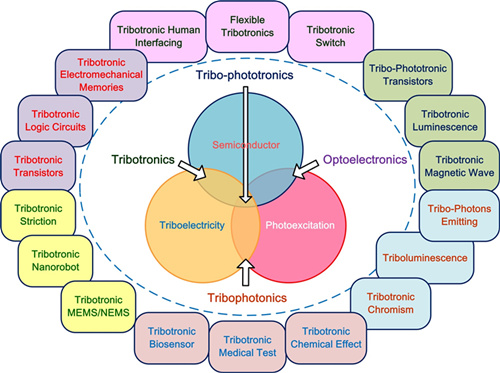 |
Fig. 1: (a) Schematic diagram of the structure of a contact-induced field effect transistor, (b, c) Top view and cross-section of the device

Figure 2: Schematic illustration of the tri-coupling of triboelectric, semi-conductor and photo-stimulatory effects and potential research and application
Recently, the research team led by Academician Zhong Lin of the Beijing Institute of Nano Energy and Systems, Chinese Academy of Sciences combined tribo-nano generators with traditional field-effect transistors to develop contact-induced electric field effect transistors. This is the first time that Tribotronics has been proposed. Research area. The relevant research results were published online on August 16 at the ACS Nano (DOI: 10.1021/nn5039806).
The core technology of field effect transistors is to use the gate voltage to control the current transport process in the components, and is widely used in integrated circuits and flexible electronics. Although the field-effect transistor technology is very mature, it requires an external gate voltage, and the sensor based on this technology lacks the mechanism of direct interaction with the external environment.
In recent years, the friction nano-generator invented by the research team of Wang Zhonglin has provided an effective way to convert mechanical energy into electrical energy. Its principle is based on the phenomenon of contact electrification and electrostatic induction, enabling two layers of membranes with opposite rubbing polarities to develop between them. The charge transfers and forms a potential difference. This potential difference serves as an internal electrical signal generated by external mechanical energy and can replace the gate voltage of a conventional field effect transistor and is used to regulate the transport properties of carriers in semiconductors.
The main team composed of Dr. Zhang Chi and Dr. Tang Wei developed the contact field-effect transistor with external force touch under the guidance of Academician Wang Zhonglin, using the coupling characteristics of friction nano-generators and metal-oxide-semiconductor field-effect transistors. . The device can contact and electrify the gate electrode material under the action of external force to form an electrostatic potential as a gate signal to realize the regulation of carrier transport characteristics in the semiconductor.
Experimental results show that under the 5V source-drain voltage input, the drain current decreases from 13.4 μA to 1.9 μA in the depletion mode when the friction material is electrified from contact to 80 μm apart. From 2.4 microamps to 12.1 microamps, the external force has been successfully controlled by the current. Since the friction nano-generator can generate a higher output voltage than the piezoelectric nano-generator and its coupling with the semiconductor effect, the contact filed-effect transistor has a wider external force sensing range and more than a piezoelectric-electronics transistor. Many material choices can be more widely used in human-computer interaction, sensors, MEMS, nano-robots, and flexible electronics.
The successful development of the contact field effect transistor has enabled the use of the electrostatic potential generated by friction as the gate signal to regulate the carrier transport properties in semiconductors. At the same time, as a basic device, a series of human-computer interaction devices capable of realizing various functions can also be derived, thereby opening up a whole new field of friction electronics.
Friction electronics couples frictional electrification and semiconductor properties and is a new application for friction nanogenerators. At the same time, as another new way of regulating carrier transport by mechanical input, it will provide an important foundation for the development of human-computer interaction intelligent interfaces together with piezoelectric electronics. With the introduction of light excitation properties, there will be further emerging fields such as friction photonics and frictional optoelectronics that are expected to be explored, and many important ones will be derived in the disciplines of materials, electromechanics, information, automation, environment, chemistry, and biomedicine. Research directions and potential applications.
Shenzhen Poolux Lighting Co., Ltd. , https://www.pooluxled.com